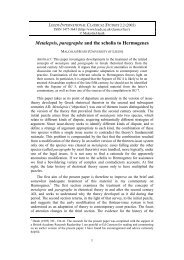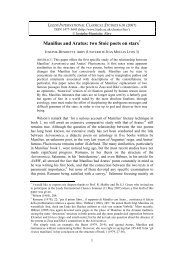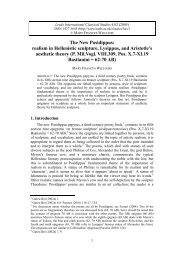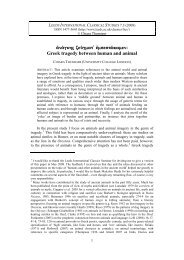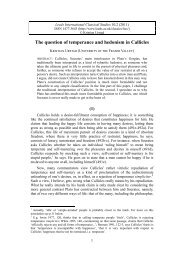Revisiting Tarpeia's myth in Propertius (IV, 4) - Leeds International ...
Revisiting Tarpeia's myth in Propertius (IV, 4) - Leeds International ...
Revisiting Tarpeia's myth in Propertius (IV, 4) - Leeds International ...
Create successful ePaper yourself
Turn your PDF publications into a flip-book with our unique Google optimized e-Paper software.
MYRTO GARANI, REVISITING TARPEIA’S MYTH IN PROPERTIUS (<strong>IV</strong>, 4)<br />
violence. In the first place, she envisages her capture by the k<strong>in</strong>g (<strong>IV</strong>.4.33-4). Next<br />
she imag<strong>in</strong>es her marriage to Tatius (<strong>IV</strong>.4.55-6). She then offers herself to be<br />
raped <strong>in</strong> revenge for the rape of the Sab<strong>in</strong>e women (<strong>IV</strong>.4.57-62), suggest<strong>in</strong>g that a<br />
violent action, i.e. war, can br<strong>in</strong>g about peace. Then aga<strong>in</strong>, Tarpeia imag<strong>in</strong>es a<br />
different scenario for peace: while <strong>in</strong> Livy the abducted Sab<strong>in</strong>e women separated<br />
the fight<strong>in</strong>g l<strong>in</strong>es by plead<strong>in</strong>g with their Sab<strong>in</strong>e brothers and fathers on the one<br />
hand and their Roman husbands on the other to make peace (1.13.2), here she<br />
<strong>in</strong>vents a counter-version to this and believes that she is able to release the forces<br />
engaged <strong>in</strong> battle by means of her wedd<strong>in</strong>g (<strong>IV</strong>.4.59-62). 32 What is even more<br />
noteworthy, with<strong>in</strong> this monologue, Tarpeia makes allusion to two <strong>myth</strong>ical tales<br />
<strong>in</strong>volv<strong>in</strong>g sexual violence with a similar historical bear<strong>in</strong>g (as we will see below)<br />
to that of Tarpeia’s betrayal, s<strong>in</strong>ce both of them ultimately led to significant<br />
political changes. 33 In the first <strong>in</strong>stance, when she mentions Romulus’ connection<br />
with the wolf that suckled him (te toga picta decet, non quem s<strong>in</strong>e matris honore /<br />
nutrit <strong>in</strong>humanae dura papilla lupae / The coloured toga suits you, not the one<br />
whom the hard teat of an <strong>in</strong>human she-wolf nourished s<strong>in</strong>ce he had no mother,<br />
<strong>IV</strong>.4.53-4), she calls to m<strong>in</strong>d the rape by Mars of another Vestal Virg<strong>in</strong>, Rhea<br />
Silvia, while she was perform<strong>in</strong>g her Vestal duties, and her punishment for it to be<br />
buried alive. 34 This rape brought about the birth of Romulus, the founder of<br />
Rome. At the same time, as we have just seen, Tarpeia explicitly refers to the rape<br />
of the Sab<strong>in</strong>e maidens, which ultimately resulted <strong>in</strong> the fusion of Sab<strong>in</strong>es with<br />
Romans. In both cases, there is a parallel process: it is strife—not love—that<br />
precedes a historical development and is revealed to be its precondition. 35<br />
As a consequence of <strong>Propertius</strong>’ double allusion to the Vergilian <strong>in</strong>tertext,<br />
while Tarpeia still appears to oscillate between love and war, these two notions<br />
acquire now a cosmological dimension, s<strong>in</strong>ce they can be viewed as the<br />
Empedoclean powers of creation and destruction. 36 In other words, given the fact<br />
that Tarpeia is already <strong>in</strong> love at the moment of Vesta’s appearance, the reader is<br />
now uncerta<strong>in</strong> as to whether Vesta can be identified with the embodiment of the<br />
32<br />
Stahl (1985) 294: ‘Tarpeia pictures a story of “The Rape of the Roman Woman” as a<br />
countermove aga<strong>in</strong>st the abduction of the Sab<strong>in</strong>e Women.’<br />
33<br />
See Arieti (1980), although his case about Empedoclean echoes <strong>in</strong> Livy is not conv<strong>in</strong>c<strong>in</strong>g.<br />
34<br />
Cf. Livy 1.4; Ovid Fasti 3.11-24; Dionys. Hal. 1.77.1.<br />
35<br />
For a different approach to violence as a factor <strong>in</strong> political development see Janan (2001) 75,<br />
who comments that ‘sexual unions, whether rapes, marriages or seductions, regularly “breach” the<br />
polity’s def<strong>in</strong><strong>in</strong>g limits so that it may move on to a new phase... The Sab<strong>in</strong>es <strong>in</strong> general figure<br />
importantly <strong>in</strong> Roman history. Their stealthy entry <strong>in</strong>to Rome sets the stage for eventually<br />
reconcil<strong>in</strong>g the two warr<strong>in</strong>g factions and, gradually, for Rome to absorb her former enemies<br />
completely.’<br />
36<br />
To add another possible <strong>in</strong>tertext, <strong>in</strong> Book 3 of Apollonius Rhodius’ Argonautica Aphrodite<br />
bribes Eros with a ball which represents the Empedoclean cosmic sphere, Σφαῖρος, <strong>in</strong>to which all<br />
the elements unite when Love takes control over them (Argon. 3.131-44). Eros then shoots his<br />
arrow at Medea: <strong>in</strong> this case, it is Empedoclean Love that regulates the cosmic order. See Hunter<br />
(1989) 111-3 ad loc. As Nelis (2000) 100 puts it: ‘Empedoclean Love and Strife seem to alternate<br />
with<strong>in</strong> the epic tradition with almost the same cyclic regularity that characterizes their control of<br />
the elements.’ For more Empedoclean echoes <strong>in</strong> Apollonius Rhodius see Kyriakou (1994); Nelis<br />
(2000).<br />
9



